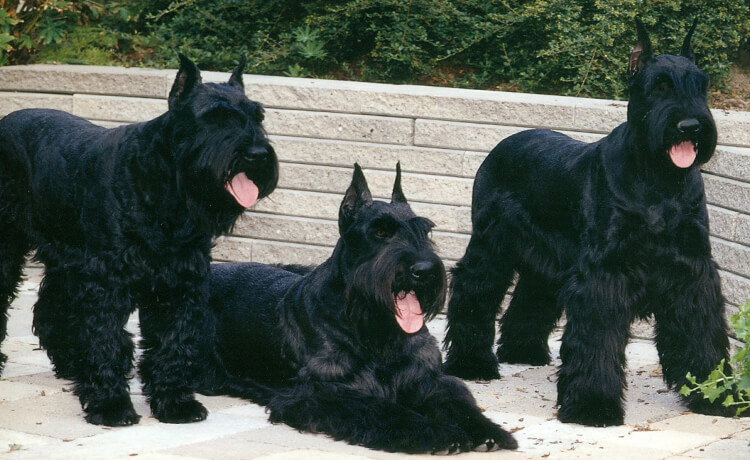
Giant Schnauzer
Giant Schnauzer Dog Breed: The Powerful and Devoted Protector
The Giant Schnauzer is the largest of the three Schnauzer breeds, known for its commanding presence, intelligence, and unwavering loyalty. Originating from Germany, these dogs were initially bred as working dogs for farms, cattle driving, and guarding property. Today, they continue to be beloved for their protective instincts and companionship.
Appearance
The Giant Schnauzer is a robust and imposing dog, characterized by its square-built body and distinctive facial hair.
- Size: Males typically stand between 25.5 to 27.5 inches, while females measure around 23.5 to 25.5 inches. Their weight can range from 55 to 95 pounds.
- Coat: They have a double coat consisting of a wiry, dense outer layer and a soft undercoat. The most common coat colors are solid black or salt-and-pepper.
- Distinctive Features: The breed’s bushy eyebrows, beard, and mustache give it a distinguished look, adding to its serious yet alert expression.
- Build: The Giant Schnauzer has a muscular, athletic build that showcases strength and agility.
Temperament
Essentials for Your Newly Adopted Pet
Welcoming a shelter pet into your life is a beautiful journey. Here are some handpicked items to help your new friend feel safe, loved, and right at home:
Giant Schnauzers are known for their confident and assertive personalities.
- Protective Nature: Highly loyal to their families, Giant Schnauzers are natural watchdogs with a strong protective streak.
- Intelligent and Trainable: This breed is quick to learn and enjoys being challenged mentally. They excel in various activities, including obedience, agility, and even search-and-rescue work.
- High Energy: Giant Schnauzers are active dogs that require significant daily exercise to stay content and well-behaved.
- Affectionate Yet Independent: While devoted and loving with their families, they can be somewhat aloof with strangers.
Exercise and Training Needs
Due to their high energy levels and intelligent nature, Giant Schnauzers thrive in environments where they receive ample physical and mental stimulation.
- Daily Exercise: At least 1-2 hours of vigorous exercise, such as long walks, runs, or play sessions, are essential for this breed.
- Training: Consistent, positive reinforcement-based training is crucial from an early age. They respond well to firm yet gentle leadership.
- Socialization: Early socialization helps them adapt to new experiences and reduces any potential for overprotectiveness or stubbornness.
- Work and Play: Giant Schnauzers benefit from having “jobs” to do, such as agility courses, advanced training, or interactive games.
Health and Lifespan
The Giant Schnauzer is generally a healthy breed but does have some potential health concerns.
- Hip Dysplasia: A common condition in large breeds, so routine screening and responsible breeding practices are key.
- Bloat (Gastric Dilatation-Volvulus): Can be life-threatening and requires immediate attention if symptoms appear.
- Hypothyroidism: May occur in some individuals and is manageable with treatment.
- Longevity: With proper care, the average lifespan of a Giant Schnauzer is 10 to 12 years.
Grooming
Grooming a Giant Schnauzer requires regular attention to maintain their coat and overall health.
- Brushing: Their wiry coat should be brushed several times a week to prevent tangles and maintain a healthy texture.
- Clipping and Hand-Stripping: Regular grooming appointments or home grooming, including hand-stripping or clipping, help manage their coat.
- Bathing: Bathing is necessary every few months or when they get particularly dirty.
- Facial Hair Care: Cleaning around their face and beard helps prevent matting and keeps them looking neat.
- Nail and Ear Care: Regular nail trims and ear cleaning are essential for their health and comfort.
History and Background
The Giant Schnauzer originated in the 17th century in Bavaria, Germany.
- Origins: Originally bred for cattle driving, they later became valued for guarding breweries and butcher shops. Their intelligence and protective nature made them suitable for military and police work.
- Popularity: The breed gained prominence in Germany and spread globally, recognized by the American Kennel Club (AKC) in 1930.
- Legacy: Known for their working abilities, they have been employed in various roles, including military service and as K-9 dogs.
Ideal Living Environment
Giant Schnauzers do best in homes where they can have space and engage in active lifestyles.
- Space Requirements: They thrive in homes with ample space and access to a yard, though they can adapt to apartment living if sufficiently exercised.
- Family Compatibility: Great for families that can dedicate time and energy to their exercise and training needs. They are generally good with children but should be supervised to ensure proper interactions.
- Experienced Owners: Ideal for those who have previous dog experience due to their strong-willed nature and training needs.
Fun Facts
- Military and Police Dogs: The Giant Schnauzer has a history of serving in military and police roles due to its alertness and trainability.
- Distinct Look: Their bearded faces and bushy eyebrows give them a unique, expressive appearance that many find endearing.
- Work Ethic: This breed’s strong desire to work and stay engaged makes them excellent companions for active and dedicated dog owners.
Conclusion
The Giant Schnauzer is a powerful, loyal, and intelligent breed that thrives in active homes with experienced owners. With proper training, exercise, and socialization, they make excellent companions and guardians. Their striking appearance and devoted nature continue to make them a cherished breed for those willing to meet their needs.
Affiliate Products
Up to 75% Discount

Dog Collar with Health Monitoring
BUY NOW »
Up to 55% Discount

Luxury Faux Furhuge Napping Bed
BUY NOW »

